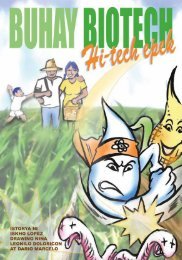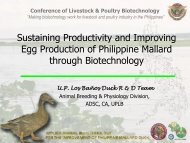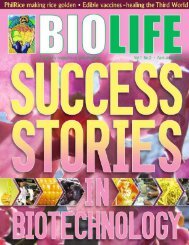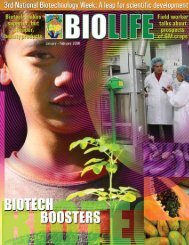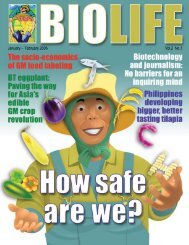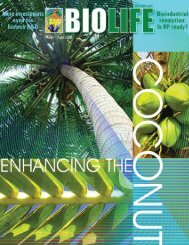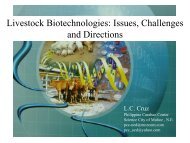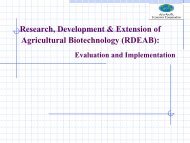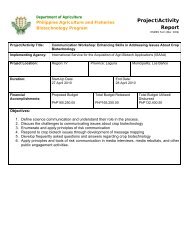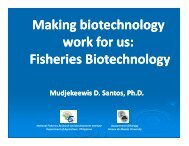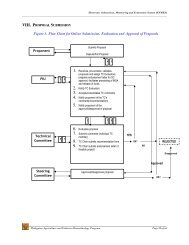Download PDF - SEARCA Biotechnology Information Center
Download PDF - SEARCA Biotechnology Information Center
Download PDF - SEARCA Biotechnology Information Center
Create successful ePaper yourself
Turn your PDF publications into a flip-book with our unique Google optimized e-Paper software.
30 BIO LIFE January – March 2005<br />
WHAT IS BIOTECHNOLOGY<br />
<strong>Biotechnology</strong> is any technique that uses a living organism<br />
(e.g., plants, animals, microorganisms) or parts of it to improve<br />
another living organism for a specific purpose. Mankind has been<br />
using biotechnology to, for instance, produce cheese, soy sauce,<br />
bread and beer, as well as lifesaving antibiotics and vaccines for<br />
rabies and hepatitis B.<br />
IS BIOTECHNOLOGY A NEW THING IN SCIENCE<br />
A big NO. While it may sound so sophisticated or mysterious—thus,<br />
something to be afraid of—biotechnology has been<br />
with mankind through the centuries, having been used, as the<br />
above cited information states, for both household (cheese and<br />
vinegar) and medicinal (antibiotics, vaccines) purposes, as well as<br />
for improving crops (interspecific<br />
and intergenetic crossbreeding).<br />
In recent years, the most<br />
significant and well-publicized strides in biotechnology have been<br />
made in agricultural applications. With the help of biotechnology,<br />
scientists seeking to find ways to feed people have come up with plant<br />
strains that are either more productive (and therefore can yield more on<br />
the same land area and the same inputs), or are pest- and diseaseresistant<br />
(and therefore substantially preserve yield and reduce crop<br />
losses while increasing the food on the table), or are even more<br />
enriched and thus boost health—or a combination or all of the above.<br />
No less than the United Nations Human Development Report<br />
2001 declares that biotechnology offers “the hope of crops with<br />
higher yields, pest- and drought-resistant properties and superior<br />
nutritional characteristics—especially for farmers in ecological<br />
zones left behind by the green revolution.”<br />
By the BIOTECH FOR LIFE MEDIA & ADVOCACY CENTER<br />
HOW CAN THE PHILIPPINES BENEFIT<br />
FROM BIOTECHNOLOGY<br />
The primary benefit of biotechnology is in agriculture,<br />
considering the Philippine situation: a fast-growing population,<br />
increasingly less land to cultivate, and the rising cost of farm<br />
inputs and of production risks. Such negative factors are being<br />
compounded by the steady liberalization of world trade, with<br />
tariff barriers for agricultural products being knocked down<br />
even as some developed countries continue to subsidize their<br />
farm sectors.<br />
As it is, developed countries are already growing biotech<br />
crops on an estimated land hectarage exceeding 40 million<br />
hectares. We can only keep up by applying biotechnology to<br />
complement the conventional methods. With biotechnology, the<br />
precarious level of forest cover<br />
will not be further jeopardized<br />
because there will be no need to<br />
clear forests to produce agricultural land. With biotechnology,<br />
plants grown on existing land area, as well as those on poor<br />
soils or stressful environments, can be made more productive.<br />
Savings can be attained from cutting down on agrochemical<br />
inputs such as pesticides. Nutritional deficiencies among<br />
Filipinos can be curbed because biotech allows staples like rice<br />
to be enriched with vitamins and minerals.<br />
IS BIOTECHNOLOGY SAFE TO HUMANS<br />
AND THE ENVIRONMENT<br />
Because it has been extensively researched and reviewed,<br />
especially as an agricultural development, the level of safety of<br />
biotechnology is repeatedly validated in thousands of field tests




